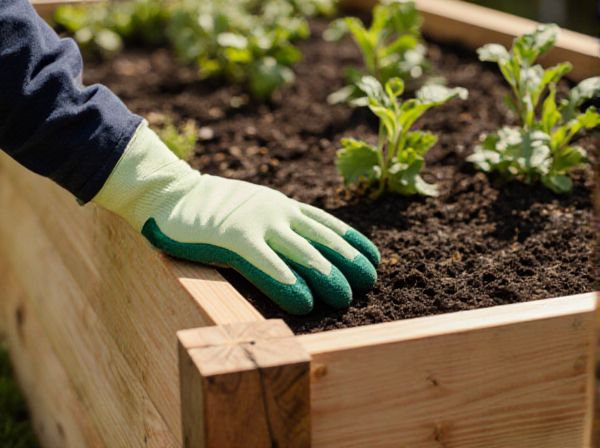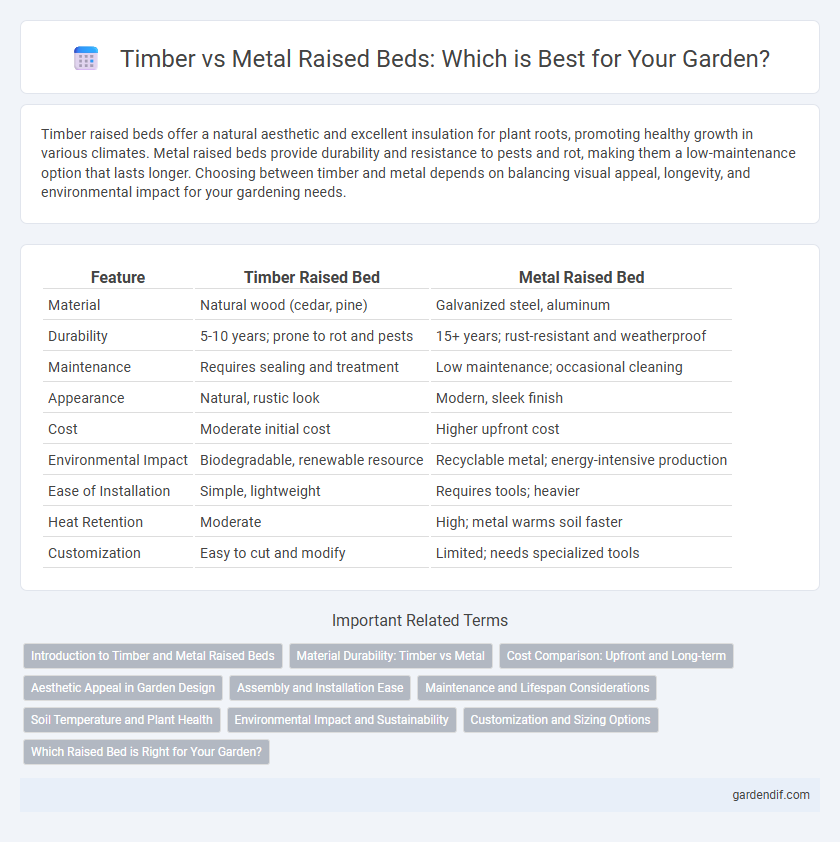
Timber raised bed vs Metal raised bed Illustration
Timber raised beds offer a natural aesthetic and excellent insulation for plant roots, promoting healthy growth in various climates. Metal raised beds provide durability and resistance to pests and rot, making them a low-maintenance option that lasts longer. Choosing between timber and metal depends on balancing visual appeal, longevity, and environmental impact for your gardening needs.
Table of Comparison
| Feature | Timber Raised Bed | Metal Raised Bed |
|---|---|---|
| Material | Natural wood (cedar, pine) | Galvanized steel, aluminum |
| Durability | 5-10 years; prone to rot and pests | 15+ years; rust-resistant and weatherproof |
| Maintenance | Requires sealing and treatment | Low maintenance; occasional cleaning |
| Appearance | Natural, rustic look | Modern, sleek finish |
| Cost | Moderate initial cost | Higher upfront cost |
| Environmental Impact | Biodegradable, renewable resource | Recyclable metal; energy-intensive production |
| Ease of Installation | Simple, lightweight | Requires tools; heavier |
| Heat Retention | Moderate | High; metal warms soil faster |
| Customization | Easy to cut and modify | Limited; needs specialized tools |
Introduction to Timber and Metal Raised Beds
Timber raised beds provide natural aesthetics and excellent insulation for soil, enhancing plant growth by maintaining consistent moisture and temperature levels. Metal raised beds offer durability, resistance to pests and rot, and a modern look, often constructed from galvanized steel or aluminum for longevity. Both options support efficient gardening but differ in maintenance requirements and environmental impact.
Material Durability: Timber vs Metal
Timber raised beds offer natural insulation and a classic aesthetic but are prone to rot, insect damage, and weathering, typically lasting 5-10 years depending on wood type and treatment. Metal raised beds, often made from galvanized steel or aluminum, provide superior durability against rust, pests, and decay, with lifespans exceeding 20 years and minimal maintenance. Choosing between timber and metal depends on climate conditions, budget, and desired longevity, with metal excelling in durability and timber favored for its organic appeal.
Cost Comparison: Upfront and Long-term
Timber raised beds generally have a lower upfront cost, making them a budget-friendly option for gardeners starting out. Metal raised beds, while more expensive initially, offer greater durability and require less maintenance over time, which can lead to cost savings in the long term. Considering factors like lifespan, weather resistance, and potential repairs helps determine the most economical choice for your gardening needs.
Aesthetic Appeal in Garden Design
Timber raised beds offer a warm, natural aesthetic that blends seamlessly with garden landscapes, enhancing organic garden designs with their rustic charm. Metal raised beds provide a sleek, modern look with clean lines and often feature powder-coated finishes that resist weathering, appealing to contemporary garden styles. Choosing between timber and metal raised beds directly influences the garden's overall aesthetic, balancing natural texture against industrial elegance.
Assembly and Installation Ease
Timber raised beds typically offer straightforward assembly with basic tools like screws and a drill, making them ideal for DIY enthusiasts seeking quick installation. Metal raised beds often require precise alignment and specialized fasteners, which can extend installation time but provide increased durability. Both options can be efficiently installed, yet timber beds generally demand less technical skill and fewer components.
Maintenance and Lifespan Considerations
Timber raised beds require regular treatment with sealants or stains to prevent rot, insect damage, and weathering, typically lasting 5 to 10 years depending on wood type and climate. Metal raised beds, often made from galvanized steel or aluminum, offer superior durability and rust resistance, generally maintaining structural integrity for 15 to 20 years with minimal upkeep. Maintenance for metal beds mainly involves periodic checks for corrosion and repainting to extend lifespan, while wooden beds demand more frequent inspections and preservation efforts.
Soil Temperature and Plant Health
Timber raised beds provide better insulation, maintaining warmer soil temperatures that promote root development and extend the growing season. Metal raised beds can conduct heat rapidly, causing soil temperatures to fluctuate, which may stress plants and inhibit growth. Consistent soil warmth in timber beds supports healthier plant development and improved nutrient uptake compared to metal counterparts.
Environmental Impact and Sustainability
Timber raised beds, especially those made from sustainably sourced or reclaimed wood, offer a lower carbon footprint and biodegradability compared to metal options. Metal raised beds, often produced from steel or aluminum, require more energy-intensive manufacturing processes and can contribute to resource depletion, though they offer longer durability and recyclability at end-of-life. Choosing timber raised beds promotes soil health and reduces reliance on non-renewable materials, aligning better with sustainable gardening practices.
Customization and Sizing Options
Timber raised beds offer extensive customization with easy cutting and shaping to fit unique garden spaces, allowing for a variety of heights, lengths, and widths tailored to individual needs. Metal raised beds provide precise sizing options with pre-fabricated panels and modular designs, enabling quick assembly and uniform structure, often featuring adjustable corners or extensions. Both materials accommodate diverse garden layouts, but timber excels in bespoke configurations while metal ensures consistent and scalable sizing solutions.
Which Raised Bed is Right for Your Garden?
Timber raised beds offer natural insulation, enhancing soil warmth and moisture retention, making them ideal for gardeners seeking organic aesthetics and eco-friendly materials. Metal raised beds provide durability, rust resistance, and a modern look, suitable for gardens requiring long-term, low-maintenance structures. Choosing the right raised bed depends on factors like climate, garden design, budget, and personal preference for sustainability versus longevity.
Timber raised bed vs Metal raised bed Infographic

 gardendif.com
gardendif.com